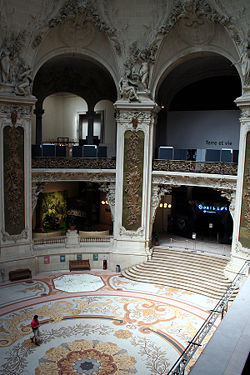
Palais de la Découverte
Encyclopedia

Science museum
A science museum or a science centre is a museum devoted primarily to science. Older science museums tended to concentrate on static displays of objects related to natural history, paleontology, geology, industry and industrial machinery, etc. Modern trends in museology have broadened the range of...
located in the Grand Palais
Grand Palais
This article contains material abridged and translated from the French and Spanish Wikipedia.The Grand Palais des Champs-Elysées, commonly known as the Grand Palais , is a large historic site, exhibition hall and museum complex located at the Champs-Élysées in the 8th arrondissement of Paris, France...
, in the 8th arrondissement on Avenue Franklin D. Roosevelt, Paris
Paris
Paris is the capital and largest city in France, situated on the river Seine, in northern France, at the heart of the Île-de-France region...
, France
France
The French Republic , The French Republic , The French Republic , (commonly known as France , is a unitary semi-presidential republic in Western Europe with several overseas territories and islands located on other continents and in the Indian, Pacific, and Atlantic oceans. Metropolitan France...
. It is open daily except Monday; an admission fee is charged.
The museum was created in 1937 by Jean Baptiste Perrin
Jean Baptiste Perrin
Jean Baptiste Perrin was a French physicist and Nobel laureate.-Early years:Born in Lille, France, Perrin attended the École Normale Supérieure, the elite grande école in Paris. He became an assistant at the school during the period of 1894-97 when he began the study of cathode rays and X-rays...
(awarded the Nobel Prize in Physics
Nobel Prize in Physics
The Nobel Prize in Physics is awarded once a year by the Royal Swedish Academy of Sciences. It is one of the five Nobel Prizes established by the will of Alfred Nobel in 1895 and awarded since 1901; the others are the Nobel Prize in Chemistry, Nobel Prize in Literature, Nobel Peace Prize, and...
, 1926) during an international exhibition on "Arts and techniques in modern life". In 1938 the French government decided to convert the facility into a new museum, which now occupies 25,000 square meters within the west wing of the Grand Palais
Grand Palais
This article contains material abridged and translated from the French and Spanish Wikipedia.The Grand Palais des Champs-Elysées, commonly known as the Grand Palais , is a large historic site, exhibition hall and museum complex located at the Champs-Élysées in the 8th arrondissement of Paris, France...
(Palais d'Antin) built for the Exposition Universelle (1900)
Exposition Universelle (1900)
The Exposition Universelle of 1900 was a world's fair held in Paris, France, from April 15 to November 12, 1900, to celebrate the achievements of the past century and to accelerate development into the next...
to designs by architect Albert-Félix-Théophile Thomas
Albert-Félix-Théophile Thomas
Albert-Félix-Théophile Thomas was a French architect.Thomas was born in Marseilles, and was a student of Alexis Paccard and Leon Vaudoyer at the École des Beaux-Arts in Paris. He won the first Prix de Rome in 1870, and became the youngest winner of the French Academy in Rome from February 15, 1871...
. In January 2010 the museum was merged with the Cité des Sciences et de l'Industrie
Cité des Sciences et de l'Industrie
The Cité des Sciences et de l'Industrie is the biggest science museum in Europe. Located in Parc de la Villette in Paris, France, it is at the heart of the Cultural Center of Science, Technology and Industry , a center promoting science and science culture.About five million people visit the Cité...
. The new institution is named universcience.
Today the museum contains permanent exhibits for mathematics
Mathematics
Mathematics is the study of quantity, space, structure, and change. Mathematicians seek out patterns and formulate new conjectures. Mathematicians resolve the truth or falsity of conjectures by mathematical proofs, which are arguments sufficient to convince other mathematicians of their validity...
, physics
Physics
Physics is a natural science that involves the study of matter and its motion through spacetime, along with related concepts such as energy and force. More broadly, it is the general analysis of nature, conducted in order to understand how the universe behaves.Physics is one of the oldest academic...
, astronomy
Astronomy
Astronomy is a natural science that deals with the study of celestial objects and phenomena that originate outside the atmosphere of Earth...
, chemistry
Chemistry
Chemistry is the science of matter, especially its chemical reactions, but also its composition, structure and properties. Chemistry is concerned with atoms and their interactions with other atoms, and particularly with the properties of chemical bonds....
, geology
Geology
Geology is the science comprising the study of solid Earth, the rocks of which it is composed, and the processes by which it evolves. Geology gives insight into the history of the Earth, as it provides the primary evidence for plate tectonics, the evolutionary history of life, and past climates...
, and biology
Biology
Biology is a natural science concerned with the study of life and living organisms, including their structure, function, growth, origin, evolution, distribution, and taxonomy. Biology is a vast subject containing many subdivisions, topics, and disciplines...
, featuring interactive experiments with commentaries by lecturers. It includes a Zeiss
Zeiss projector
A Zeiss projector is one of a line of planetarium projectors manufactured by the Carl Zeiss Company.The first modern planetarium projectors were designed and built in 1924 by the Zeiss Works of Jena, Germany in 1924. Zeiss projectors are designed to sit in the middle of a dark, dome-covered room...
planetarium
Planetarium
A planetarium is a theatre built primarily for presenting educational and entertaining shows about astronomy and the night sky, or for training in celestial navigation...
with 15-meter dome.

